1. Overview
Paavo Johannes Nurmi (Paavo Johannes Nurmiˈpɑːʋo ˈnurmiFinnish; June 13, 1897 - October 2, 1973) was a Finnish middle-distance and long-distance runner who dominated the sport in the 1920s, earning him the nickname "Flying Finn". Born into a working-class family, Nurmi left school at a young age to support his family, but was inspired by Olympic feats to pursue athletics. He developed a strict, analytical training regimen, famously using a stopwatch to maintain an "even pace," which revolutionized distance running.
Nurmi set 22 official world records across distances ranging from 1,500 meters to 20 kilometers. He competed in three Olympic Games between 1920 and 1928, securing an impressive nine gold and three silver medals in 12 events. At his peak, Nurmi was undefeated in 121 races at distances from 800 meters upwards, and remained unbeaten in cross country events and the 10,000 meters throughout his 14-year career. His Olympic aspirations for 1932 were controversially cut short due to a dispute over his amateur status. After retiring from running, Nurmi became a successful businessman in various sectors, including haberdashery and construction, and also contributed to his country during wartime by fundraising and serving in the military. He served as the final torchbearer at the 1952 Summer Olympics in Helsinki, a moment that cemented his legendary status. Nurmi's achievements, innovative training methods, and famously private personality left a profound and lasting impact on the world of athletics and beyond.
2. Early Life and Background
Paavo Nurmi's early life in Turku, Finland, was marked by financial hardship and a strong work ethic, which shaped his disciplined approach to athletics.
2.1. Birth and Family
Nurmi was born on June 13, 1897, in Turku, then part of the Grand Duchy of Finland, to Johan Fredrik Nurmi, a carpenter, and Matilda Wilhelmiina Laine. He was the eldest of five children; his siblings were Siiri (born 1898), Saara (born 1902), Martti (born 1905), and Lahja (born 1908). In 1903, his family moved from Raunistula to a 40-NaN Q ft2 (NaN Q m2) apartment in central Turku, where Nurmi resided until 1932. The family faced financial difficulties, especially after his father died in 1910 and his sister Lahja passed away a year later. To cope, they rented out their kitchen and lived in a single room.
2.2. Childhood and Education
Despite being a talented student, Nurmi left school at the age of 12 to work as an errand boy for a bakery, contributing to his family's income. Although he stopped actively running during this period, he gained significant physical exercise by pushing heavy carts up the steep slopes of Turku. He later attributed these climbs to strengthening his back and leg muscles. By the age of eleven, he had already demonstrated early athletic promise, running the 1500 meters in 5:02. Nurmi later pursued further education, graduating as an engineer in 1923.
2.3. Inspiration and Training Start
At 15, Nurmi's interest in athletics was rekindled by the Olympic achievements of Hannes Kolehmainen, who was lauded for "running Finland onto the map of the world" at the 1912 Summer Olympics. Inspired, Nurmi bought his first pair of sneakers days later. His initial training primarily involved cross country running in the summers and cross country skiing in the winters. In 1914, he joined the sports club Turun Urheiluliitto and won his first 3000-meter race. Two years later, he refined his training to include walking, sprints, and calisthenics. He continued to support his family through a new job at the Ab. H. Ahlberg & Co workshop in Turku until he began his military service. During the Finnish Civil War in 1918, Nurmi remained politically neutral, focusing on his work and Olympic ambitions. After the war, he chose not to join the newly formed Finnish Workers' Sports Federation, but he wrote articles for their publication, criticizing discrimination against fellow workers and athletes.
2.4. Military Service and Early Competitions
Nurmi began his military service in April 1919, joining a machine gun company in the Pori Brigade. He quickly distinguished himself in athletic competitions; while others marched, Nurmi ran entire distances with a rifle on his shoulder and a sand-filled backpack. His stubbornness often led to conflicts with non-commissioned officers, but he was favored by superior officers, including unit commander Hugo Österman, a known sports enthusiast, who granted Nurmi and other athletes free time for practice. Nurmi devised innovative training methods in the barracks, such as running behind trains while holding onto the rear bumper to extend his stride, and using heavy iron-clad army boots to strengthen his legs. These methods helped him achieve personal bests and approach Olympic selection standards. In March 1920, he was promoted to corporal (alikersanttiFinnish). On May 29, 1920, he set his first national record in the 3000 meters and went on to win both the 1500 meters and 5000 meters at the Olympic trials in July.
Nurmi's early career records (1914-1919) are summarized below:
| Year | 1500 m | 2000 m | 3000 m | 5000 m | 10000 m |
|---|---|---|---|---|---|
| 1914 | 10:06.5 | ||||
| 1915 | 6:06.8 | 9:30 | 15:50.7 | ||
| 1916 | 5:55 | 15:52.8 | |||
| 1917 | 15:47.5 | ||||
| 1918 | 4:29 | 15:50.7 | |||
| 1919 | 8:58.1 | 15:31.5 | 32:56 |
3. Olympic Career
Paavo Nurmi's Olympic career was characterized by remarkable dominance, strategic innovation, and a controversial end, establishing him as one of the greatest athletes in Olympic history.
3.1. 1920 Antwerp Olympics
Nurmi made his international debut at the 1920 Summer Olympics in Antwerp, Belgium. He earned his first Olympic medal by finishing second to France's Joseph Guillemot in the 5000 meters, which would be the only time Nurmi lost to a non-Finnish runner in the Olympics. He then went on to win gold medals in his other three events. In the 10,000 meters, he sprinted past Guillemot on the final curve, improving his personal best by over a minute. He also secured gold in the individual cross country race, defeating Sweden's Eric Backman, and contributed to Finland's victory in the team cross country event alongside Heikki Liimatainen and Teodor Koskenniemi, who collectively defeated the British and Swedish teams. Nurmi's Olympic success brought practical improvements to his family's life in Turku, including electric lighting and running water. He also received a scholarship to study at the Teollisuuskoulu industrial school in Helsinki.
3.2. 1924 Paris Olympics
Motivated by his defeat to Guillemot, Nurmi began treating his races as meticulous experiments, analyzing his performances to perfect his technique and tactics. He started carrying a stopwatch during races to maintain an "even pace," a departure from his earlier strategy of blistering starts. Nurmi set his first world record in the 10,000 meters in Stockholm in 1921. By 1922, he had broken world records in the 2000 meters, 3000 meters, and 5000 meters. A year later, he added the 1500 meters and the mile records, becoming the first and only runner to simultaneously hold world records for the mile, 5000 meters, and 10,000 meters. He also won the 1923 Finnish Championships in the 800 meters, setting a new national record.
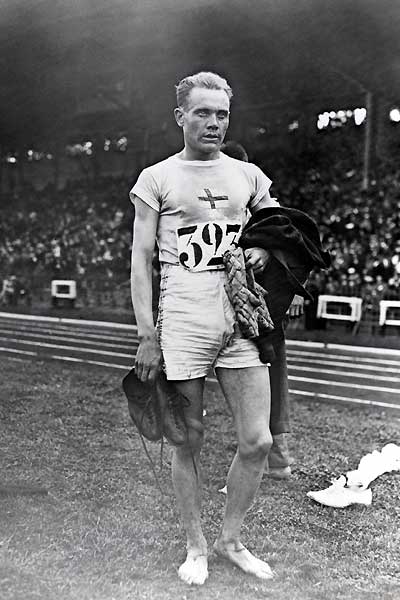
Nurmi's participation in the 1924 Summer Olympics was initially jeopardized by a knee injury in spring 1924, but he recovered and resumed training twice daily. On June 19, in a remarkable preview of the Olympic schedule, he ran the 1500 meters and 5000 meters within an hour at Eläintarha Stadium in Helsinki, setting new world records for both distances. In the 1500 meters final in Paris, Nurmi started at an aggressive pace, running the first 800 meters nearly three seconds faster than his world record pace. His only challenger, Ray Watson of the United States, gave up before the final lap, allowing Nurmi to slow down and still win, breaking the Olympic record by three seconds. The 5000 meters final began less than two hours later, presenting a formidable challenge from his compatriot Ville Ritola, who had already won the 3000 meters steeplechase and the 10,000 meters. Ritola and Sweden's Edvin Wide attempted to exhaust Nurmi by running at a world-record pace, but Nurmi, realizing he was racing men, not the clock, famously tossed his stopwatch onto the grass. The Finns eventually outpaced Wide, and Nurmi held off Ritola in a final sprint to win by a meter.
The cross country events in Paris were held in extreme heat, reaching 113 °F (45 °C). Out of 38 competitors, only 15 finished, with eight requiring stretchers. Early leader Wide collapsed and was mistakenly reported to have died. Nurmi, however, showed only minor signs of exhaustion, beating Ritola by nearly a minute and a half. The Finnish team's gold medal in the team cross country event was secured when a disoriented Heikki Liimatainen staggered into the stadium, barely moving, and after a moment of confusion, finally crossed the finish line in 12th place. The severe conditions led Olympic officials to ban cross country running from future Games.
The following day, in the 3000 meters team race, Nurmi and Ritola again finished first and second, with Elias Katz securing the gold medal for the Finnish team by finishing fifth. Despite winning five gold medals in five events, Nurmi left the Games embittered because Finnish officials had prevented him from defending his title in the 10,000 meters, a distance he cherished. Upon returning to Finland, Nurmi set a new 10,000 meters world record that would stand for nearly 13 years. At this point, he simultaneously held the world records for the 1500 meters, the mile, the 3000 meters, the 5000 meters, and the 10,000 meters.
3.3. 1928 Amsterdam Olympics
In early 1925, Nurmi embarked on a highly publicized tour of the United States, competing in 55 events (45 indoors) over five months, starting with a sold-out debut at Madison Square Garden on January 6. He replicated his Helsinki and Paris successes, defeating Joie Ray and Lloyd Hahn in the mile and Ritola in the 5000 meters, setting new world records in both. Nurmi broke ten more indoor world records and several best times for rarer distances, winning 51 of his events. His only loss in an individual scratch race at distances from 800 meters upwards came in his final event, a half-mile race at Yankee Stadium, where he finished second to American track star Alan Helffrich, ending Nurmi's 121-race, four-year winning streak. Despite his strong aversion to losing, Nurmi was the first to congratulate Helffrich. The tour made Nurmi immensely popular in the United States, and he met President Calvin Coolidge at the White House. Nurmi left America concerned that he had competed too frequently and risked burning himself out.
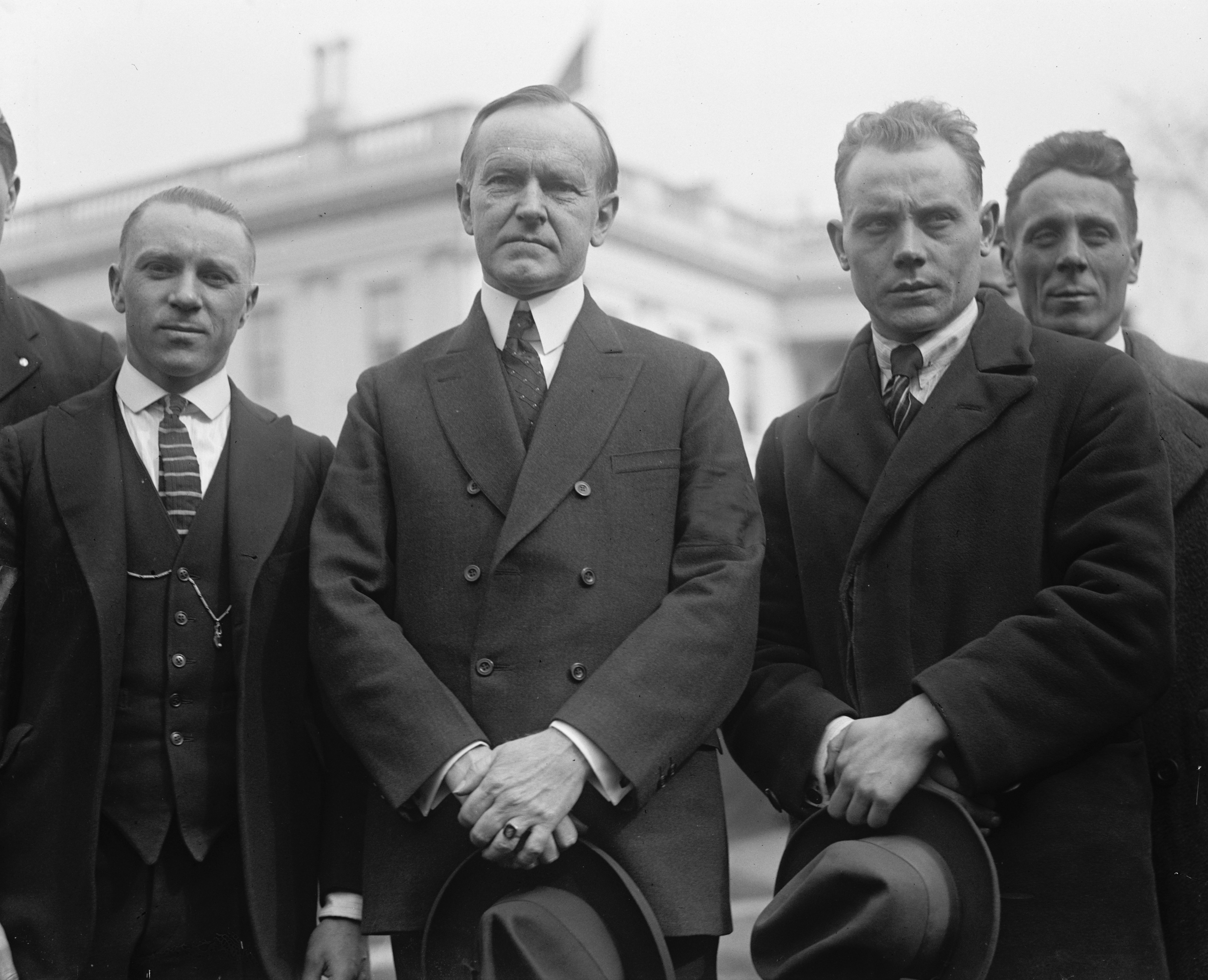
Following his exhaustive U.S. tour, Nurmi struggled with motivation, exacerbated by rheumatism and Achilles tendon problems. He resigned from his job as a machinery draughtsman in 1926 to focus on business studies. With Risto Ryti, director of the Bank of Finland, as one of his financial advisors, Nurmi began a new career as a share dealer. In 1926, he broke Wide's 3000 meters world record in Berlin and further improved it in Stockholm, despite Nils Eklöf's repeated attempts to slow his pace to aid Wide. Nurmi was furious and vowed never to race Eklöf again. In October 1926, he lost a 1500 meters race and his world record to Germany's Otto Peltzer, marking his first defeat at a distance over 1000 meters in over five years and 133 races. In 1927, Finnish officials barred him from international competition for refusing to run against Eklöf at the Finland-Sweden athletics international, canceling a scheduled rematch with Peltzer. Nurmi ended his season and threatened to withdraw from the 1928 Summer Olympics until late November. At the 1928 Olympic trials, he finished third in the 1500 meters, behind eventual gold medalist Harri Larva and bronze medalist Eino Purje, leading him to concentrate on longer distances. He also added the steeplechase to his program, an event he had only attempted twice before.
At the 1928 Olympics in Amsterdam, Nurmi competed in three events. He won the 10,000 meters by closely trailing Ritola before sprinting past him on the home straight. Before the 5000 meters final, Nurmi injured himself in his qualifying heat for the 3000 meters steeplechase, falling on his back at the water jump and spraining his hip and foot. Lucien Duquesne stopped to help him, and Nurmi, in gratitude, paced Duquesne past the field and offered him the heat win, which Duquesne declined. In the 5000 meters final, Nurmi attempted to repeat his move on Ritola but was outpaced by his teammate, looking more exhausted than ever before, barely holding off Wide for the silver medal. With little time to rest or nurse his injuries, the 3000 meters steeplechase final began the next day. Struggling with the hurdles, Nurmi allowed Finland's steeplechase specialist Toivo Loukola to gain a significant lead. On the final lap, Nurmi surged ahead of the other competitors, finishing nine seconds behind Loukola, whose time set a new world record; Nurmi's time also surpassed the previous record. Although Ritola did not finish, Ove Andersen completed a Finnish sweep of the medals.
3.4. 1932 Los Angeles Olympics Disqualification
After the 1928 Olympics, Nurmi stated to a Swedish newspaper that it would be his last season on the track, believing he was "beginning to get old" after 15 years of racing. However, he continued his career, shifting his focus to even longer distances. In October 1928, he broke the world records for the 15 kilometers, 10 miles, and the one hour run in Berlin. Nurmi's one-hour record stood for 17 years until Viljo Heino ran 129 meters further in 1945. In January 1929, Nurmi began his second U.S. tour in Brooklyn. He experienced his first-ever defeat in the mile to Ray Conger at the indoor Wanamaker Mile, finishing seven seconds slower than his 1925 world record. This led to speculation that the mile had become too short a distance for him. In 1930, he set a new world record for the 20 kilometers. In July 1931, Nurmi demonstrated he still possessed speed for shorter distances by beating Lauri Lehtinen, Lauri Virtanen, and Volmari Iso-Hollo, breaking the world record for the now-rare 2 miles, becoming the first runner to complete the distance in under nine minutes. Nurmi planned to compete only in the 10,000 meters and the marathon at the 1932 Summer Olympics in Los Angeles, stating that Finland had "at least three excellent men for that event" (the 5000 meters).
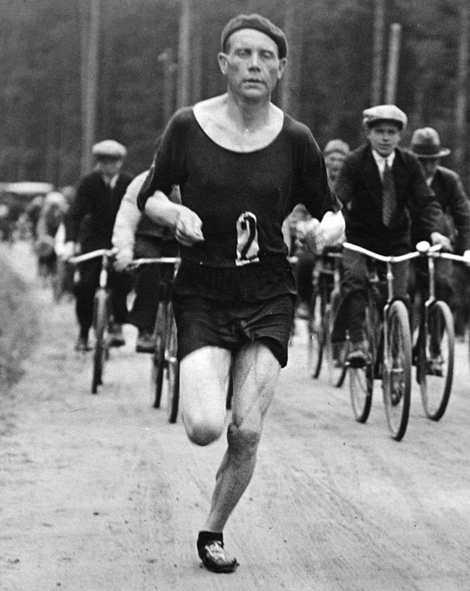
In April 1932, the executive council of the International Amateur Athletics Federation (IAAF) provisionally suspended Nurmi from international athletics, pending an investigation into his amateur status by the Finnish Athletics Federation. Finnish authorities criticized the IAAF for acting without a hearing but agreed to investigate. A week later, the Finnish Athletics Federation ruled in Nurmi's favor, finding no evidence of professionalism, and Nurmi was hopeful his suspension would be lifted in time for the Games.
On June 26, 1932, Nurmi ran his first marathon at the Olympic trials in Viipuri. He completed the old-style 'short marathon' of 25 mile (40.2 km) in 2:22:03.8 without drinking any liquid. This pace would have put him on track to finish a full marathon in approximately 2:29:00, just under Albert Michelsen's then-marathon world record of 2:29:01.8. He led Armas Toivonen, who would go on to win an Olympic bronze medal, by six minutes. Confident in his performance, Nurmi stopped and retired from the race due to an Achilles tendon problem. The Finnish Olympic Committee entered Nurmi for both the 10,000 meters and the marathon. Despite his injury, Nurmi trained at the Olympic Village in Los Angeles, determined to end his career with a marathon gold medal, as his idol Kolehmainen had done.
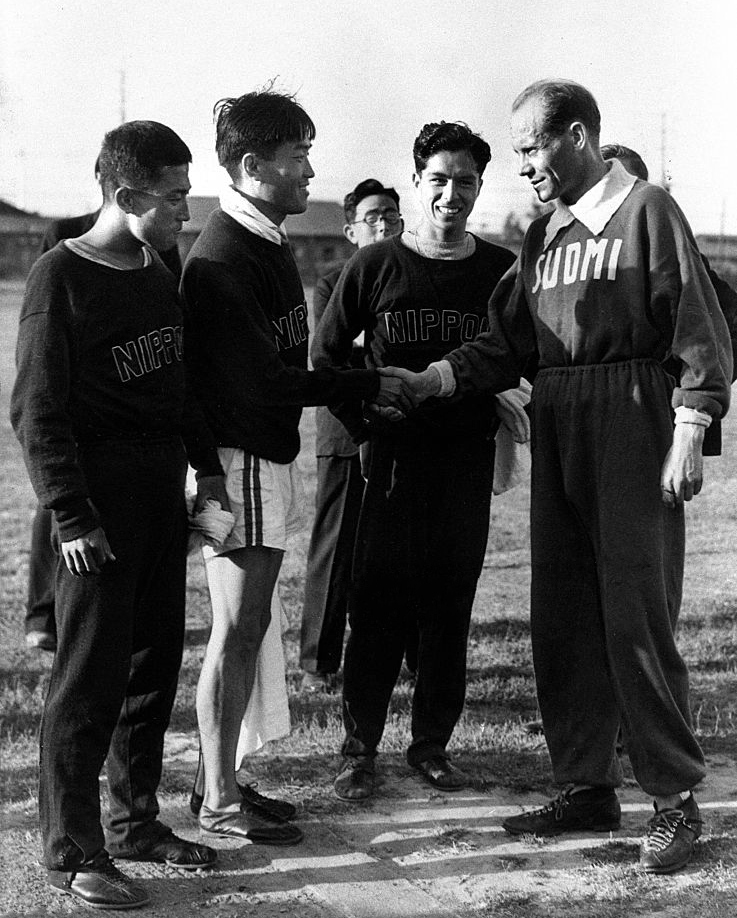
Less than three days before the 10,000 meters, a special commission of the IAAF, composed of the same seven members who had initially suspended Nurmi, rejected his entries and barred him from competing in Los Angeles. Sigfrid Edström, the Swedish chairman of the IAAF Council, unilaterally pushed for this ban without consulting the Finnish Sports Federation (SUL) or Nurmi. The evidence against Nurmi was believed to be sworn statements from German race promoters, claiming Nurmi had received $250-500 per race in Germany in autumn 1931. These statements were reportedly obtained by Karl Ritter von Halt after Edström threatened "stringent action" against the German Athletics Association if evidence against Nurmi was not provided. This decision was criticized as a "slick political maneuver" and caused widespread protest in Helsinki. The IOC did not follow its own rules, which stated that protests had to be made "within 30 days from the closing ceremonies of the games."
On the eve of the marathon, all race entrants except the Finns filed a petition asking for Nurmi's entry to be accepted. Bo Ekelund, secretary general of the IAAF and head of the Swedish Athletics Federation, suggested Nurmi could participate in the marathon outside the official competition, but Finland insisted that as long as he was not declared a professional, he had the right to compete officially. Despite a pulled Achilles tendon diagnosis two weeks prior, Nurmi maintained he would have won the event by five minutes. The IAAF congress concluded without Nurmi being declared a professional, but the council's authority to disbar an athlete was upheld by a narrow 13-12 vote. The matter was postponed until the 1934 meet in Stockholm. Finns accused Swedish officials of using "devious tricks" in their campaign against Nurmi's amateur status, leading to a cessation of all athletic relations with Sweden until 1939.
Nurmi refused to turn professional and continued to run as an amateur in Finland. In 1933, he ran his first 1500 meters in three years, winning the national title with his best time since 1926. At the August 1934 IAAF meet, Finland's proposals to clear Nurmi were rejected. The council then passed a resolution empowering it to suspend athletes violating the amateur code, and with a 12-5 vote (with many abstentions), Nurmi's suspension from international amateur athletics became definite. Less than three weeks later, Nurmi retired from running with a 10,000 meters victory in Viipuri on September 16, 1934. He remained undefeated in the 10,000 meters throughout his 14-year top-level career and maintained a 19-year winning streak in cross country running.
4. Athletic Achievements and Records
Paavo Nurmi's career was marked by an unprecedented number of world records and a revolutionary approach to training and pacing, solidifying his statistical dominance in middle and long-distance running.
4.1. World Records
Nurmi set 22 official world records across distances between 1500 meters and 20 kilometers, a record in running. He also established many more unofficial records, totaling 58. His indoor world records were considered unofficial, as the IAAF did not ratify indoor records until the 1980s.
Below are his IAAF-ratified world records:
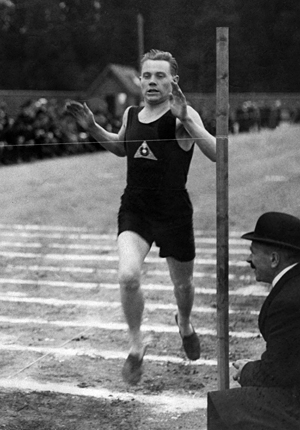
| Distance | Mark | Date | Location |
|---|---|---|---|
| 1500 m | 3:52.6 | June 19, 1924 | Helsinki |
| Mile | 4:10.4 | August 23, 1923 | Stockholm |
| 2000 m | 5:26.3 | September 4, 1922 | Tampere |
| 2000 m | 5:24.6 | June 18, 1927 | Kuopio |
| 3000 m | 8:28.6 | August 27, 1922 | Turku |
| 3000 m | 8:25.4 | May 24, 1926 | Berlin |
| 3000 m | 8:20.4 | July 13, 1926 | Stockholm |
| 2 miles | 8:59.6 | July 24, 1931 | Helsinki |
| 3 miles | 14:11.2 | August 24, 1923 | Stockholm |
| 5000 m | 14:35.4 | September 12, 1922 | Stockholm |
| 5000 m | 14:28.2 | June 19, 1924 | Helsinki |
| 4 miles | 19:15.4 | October 1, 1924 | Viipuri |
| 5 miles | 24:06.2 | October 1, 1924 | Viipuri |
| 6 miles | 29:36.4 | June 8, 1930 | London |
| 10,000 m | 30:40.2 | June 22, 1921 | Stockholm |
| 10,000 m | 30:06.2 | August 31, 1924 | Kuopio |
| 15000 m | 46:49.6 | October 7, 1928 | Berlin |
| 10 miles | 50:15.0 | October 7, 1928 | Berlin |
| One hour run | 63 K ft (19.21 K m) | October 7, 1928 | Berlin |
| 20,000 m | 1:04:38.4 | September 3, 1930 | Stockholm |
| 4 × 1500 m | 16:26.2 | July 12, 1926 | Stockholm |
| 4 × 1500 m | 16:11.4 | July 17, 1926 | Viipuri |
Below are his unofficial world records:
| Distance | Mark | Date | Location |
|---|---|---|---|
| 1500 m | 3:53.0 | August 23, 1923 | Stockholm |
| 1500 m (indoor) | 3:56.2 | January 6, 1925 | New York City |
| Mile (indoor) | 4:13.5 | January 6, 1925 | New York City |
| Mile (indoor) | 4:12.0 | March 7, 1925 | Buffalo |
| 2000 m (indoor) | 5:33.0 | January 17, 1925 | New York City |
| 2000 m (indoor) | 5:30.2 | January 28, 1925 | New York City |
| 2000 m (indoor) | 5:22.4 | February 12, 1925 | Buffalo |
| 3000 m | 8:27.8 | September 17, 1923 | Copenhagen |
| 3000 m (indoor) | 8:26.8 | January 15, 1925 | New York City |
| 3000 m (indoor) | 8:26.4 | March 12, 1925 | New York City |
| 2 miles (indoor) | 9:08.0 | February 7, 1925 | New York City |
| 2 miles (indoor) | 8:58.2 | February 14, 1925 | New York City |
| 3 miles | 14:14.4 | August 10, 1922 | Kokkola |
| 3 miles | 14:08.4 | September 12, 1922 | Stockholm |
| 3 miles | 14:02.0 | June 19, 1924 | Helsinki |
| 5000 m (indoor) | 14:44.6 | January 6, 1925 | New York City |
| 4 miles | 19:18.8 | August 31, 1924 | Kuopio |
| 5 miles | 24:13.2 | August 31, 1924 | Kuopio |
| 6 miles | 29:41.2 | June 22, 1921 | Stockholm |
| 6 miles | 29:07.1 | August 31, 1924 | Kuopio |
| 25-mile marathon | 2:22:03.8 | June 26, 1932 | Viipuri |
4.2. Season and Event Summaries
Nurmi's career statistics reflect his consistent success and dominance across various distances and seasons. The "Starts" figure excludes heats, handicap races, relays, and events where Nurmi raced alone against relay teams. "Podiums" indicates top-three finishes, and "DNF" means "Did Not Finish".
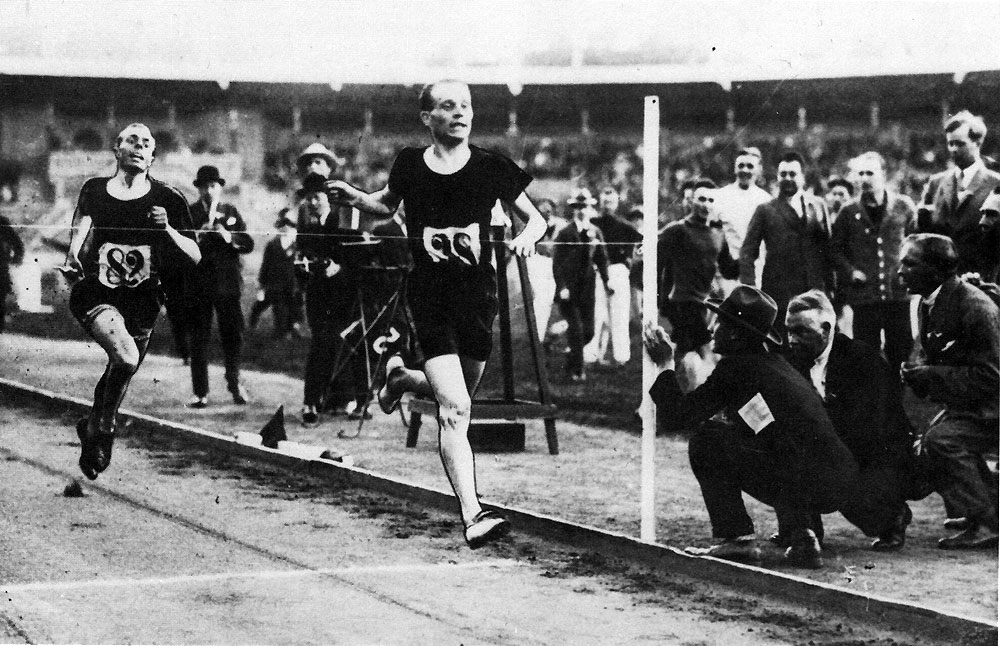
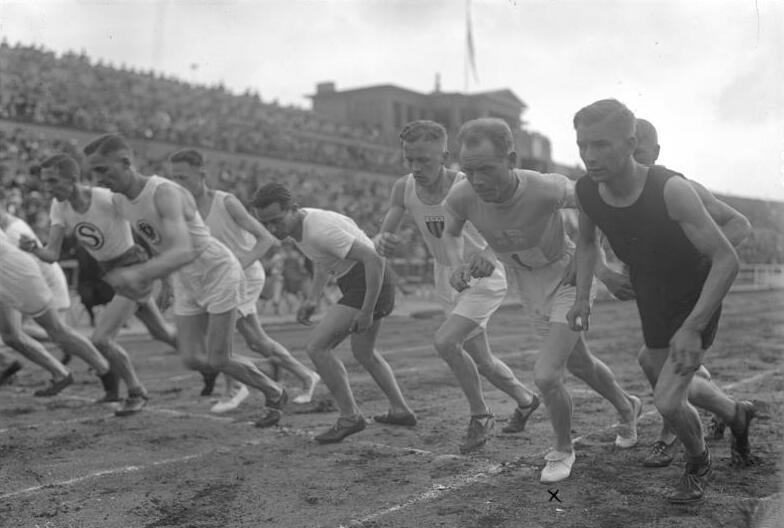
- Season Summaries:**
| Season | Distances | Starts | Wins | Podiums | DNF |
|---|---|---|---|---|---|
| 1920 | 1500 m - 10,000 m | 14 | 13 | 14 | 0 |
| 1921 | 800 m - 10,000 m | 17 | 15 | 16 | 0 |
| 1922 | 800 m - 4 miles | 20 | 20 | 20 | 0 |
| 1923 | 800 m - 5000 m | 23 | 23 | 23 | 0 |
| 1924 | 800 m - 10,000 m | 25 | 25 | 25 | 0 |
| 1925 | 800 m - 10,000 m | 58 | 56 | 57 | 1 |
| 1926 | 1000 m - 10,000 m | 19 | 16 | 19 | 0 |
| 1927 | 1500 m - 5000 m | 12 | 12 | 12 | 0 |
| 1928 | 1500 m - One hour run | 15 | 12 | 15 | 0 |
| 1929 | Mile - 6 miles | 14 | 12 | 14 | 0 |
| 1930 | 1500 m - 20,000 m | 11 | 11 | 11 | 0 |
| 1931 | 2 miles - 7 miles | 16 | 14 | 14 | 2 |
| 1932 | 10,000 m - Marathon | 3 | 2 | 2 | 1 |
| 1933 | 1500 m - 25,000 m | 16 | 13 | 15 | 1 |
| 1934 | 3000 m - 10,000 m | 8 | 8 | 8 | 0 |
- Event Summaries:**
| Event | Years | Starts | Wins | Podiums | DNF |
|---|---|---|---|---|---|
| 800 m / 880 yd | 1921-1925 | 8 | 6 | 8 | 0 |
| 1500 m | 1920-1933 | 33 | 30 | 32 | 0 |
| Mile | 1920-1929 | 10 | 9 | 10 | 0 |
| 3000 m | 1920-1934 | 29 | 27 | 29 | 0 |
| 2 miles | 1922-1931 | 23 | 22 | 23 | 0 |
| 5000 m | 1920-1934 | 71 | 67 | 69 | 2 |
| 10,000 m | 1920-1934 | 17 | 17 | 17 | 0 |
| Cross country | 1920-1934 | 23 | 23 | 23 | 0 |
- Olympic Results:**
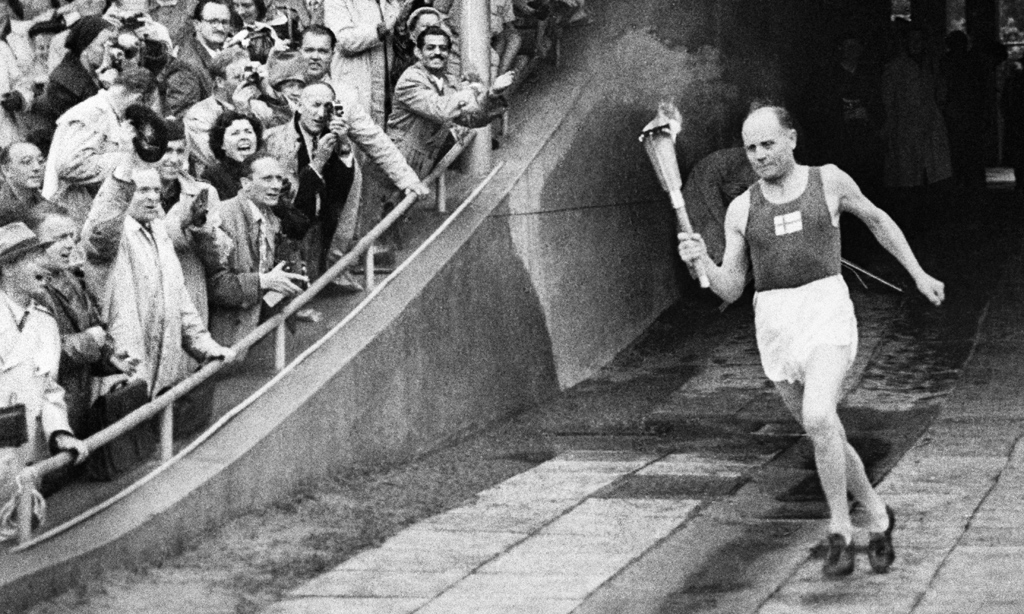
| Year | Date | Event | Mark | Result |
|---|---|---|---|---|
| 1920 | August 16 | 5000 m - heat 3 | 15:33.0 | Q (2nd) |
| August 17 | 5000 m - final | 15:00.5 | 2nd | |
| August 19 | 10,000 m - heat 1 | 33:46.3 | Q (2nd) | |
| August 20 | 10,000 m - final | 31:45.8 | 1st | |
| August 22 | Individual cross country | 27:15.0 | 1st | |
| Team cross country | 10 pts | 1st | ||
| 1924 | July 8 | 5000 m - heat 2 | 15:28.6 | Q (1st) |
| July 9 | 1500 m - heat 3 | 4:07.6 | Q (1st) | |
| July 10 | 1500 m - final | 3:53.6 (OR) | 1st | |
| 5000 m - final | 14:31.2 (OR) | 1st | ||
| July 11 | 3000 m team race - heat 1 | 8:47.8 (1st) | Q (1st) | |
| July 12 | Individual cross country | 32:54.8 | 1st | |
| Team cross country | 11 pts | 1st | ||
| July 13 | 3000 m team race - final | 8:32.0 (1st) | 1st | |
| 1928 | July 29 | 10,000 m | 30:18.8 (OR) | 1st |
| July 31 | 5000 m - heat 3 | 15:08.0 | Q (4th) | |
| August 1 | 3000 m steeplechase - heat 2 | 9:58.8 | Q (1st) | |
| August 3 | 5000 m - final | 14:40.0 | 2nd | |
| August 4 | 3000 m steeplechase - final | 9:31.2 | 2nd |
4.3. Training Philosophy
Nurmi was famously secretive about his training methods during his active career. He always ran alone, often increasing his pace to quickly exhaust anyone who dared to join him. Even his club mate Harri Larva learned little from him. After retiring, Nurmi became a coach for the Finnish Athletics Federation, training runners for the 1936 Summer Olympics in Berlin.
Nurmi introduced the "even pace" strategy to running, meticulously pacing himself with a stopwatch to distribute his energy uniformly throughout a race. His reasoning was that "when you race against time, you don't have to sprint. Others can't hold the pace if it is steady and hard all through to the tape." This analytical approach to running was a significant innovation. Nurmi was also considered a pioneer in training, developing a systematic, year-round program that incorporated both long-distance work and interval running. He emphasized the importance of psychological strength, famously stating: "Mind is everything; muscle, pieces of rubber. All that I am, I am because of my mind."
Regarding Nurmi's methodical style, fellow athlete Otto Peltzer observed that "in his impenetrability he was a Buddha gliding on the track. Stopwatch in hand, lap after lap, he ran towards the tape, subject only to the laws of a mathematical table." Nurmi's innovations accelerated the progress of world records and profoundly influenced athletics not only in Finland but globally. His style, technique, and tactics were considered infallible, inspiring successive imitators in Finland to consistently improve records.
5. Later Life and Post-Athletic Career
After his competitive running career, Nurmi transitioned into a successful business life and continued to contribute to his country, while maintaining a private demeanor.
5.1. Coaching and Business Ventures
After retiring from competitive running, Nurmi became a coach for the Finnish Athletics Federation, training runners for the 1936 Summer Olympics in Berlin. In 1935, Nurmi, along with the entire board of directors, resigned from the federation after a contentious vote (40-38) to resume athletic relations with Sweden. However, he returned to coaching three months later, and the Finnish distance runners subsequently achieved significant success at the Games, winning three gold, three silver, and one bronze medal.
In 1936, Nurmi opened a men's clothing store (haberdashery) in Helsinki, which became a popular tourist attraction. Even renowned athletes like Emil Zátopek visited the store hoping to meet Nurmi. While the store operated, Nurmi spent his time in the back room managing another new venture: construction. As a contractor, he built forty apartment buildings in Helsinki, each containing approximately a hundred flats. Within five years, he was considered a millionaire. His fierce rival, Ville Ritola, even ended up living in one of Nurmi's flats at half price. Nurmi also found success in the stock market, eventually becoming one of Finland's wealthiest individuals.
5.2. Fundraising and Wartime Contributions
In February 1940, during the Winter War between Finland and the Soviet Union, Nurmi traveled to the United States with his protégé Taisto Mäki, who had become the first man to run the 10,000 meters in under 30 minutes. Their purpose was to raise funds and rally support for Finland. The relief drive, overseen by former U.S. President Herbert Hoover, included a coast-to-coast tour by Nurmi and Mäki. Hoover welcomed them as "ambassadors of the greatest sporting nation in the world." While in San Francisco, Nurmi received the tragic news that one of his apprentices, 1936 Olympic champion Gunnar Höckert, had been killed in action. Nurmi returned to Finland in late April and served in the Continuation War in a delivery company and as a trainer within the military staff. Before his discharge in January 1942, Nurmi was promoted first to staff sergeant (ylikersanttiFinnish) and later to sergeant first class (vääpeliFinnish).
5.3. Later Years and Death
In 1952, Nurmi was persuaded by Urho Kekkonen, then Prime Minister of Finland and former chairman of the Finnish Athletics Federation, to carry the Olympic torch into the Helsinki Olympic Stadium at the 1952 Summer Olympics in Helsinki. His appearance astonished the spectators; Sports Illustrated described how "his celebrated stride was unmistakable to the crowd. When he came into view, waves of sound began to build throughout the stadium, rising to a roar, then to a thunder. When the national teams, assembled in formation on the infield, saw the flowing figure of Nurmi, they broke ranks like excited schoolchildren, dashing toward the edge of the track." After lighting the flame in the Olympic Cauldron, Nurmi passed the torch to his idol, Hannes Kolehmainen, who lit the beacon in the tower. Nurmi had been planned to lead a group of fifty Finnish gold medal winners at the cancelled 1940 Summer Olympics.
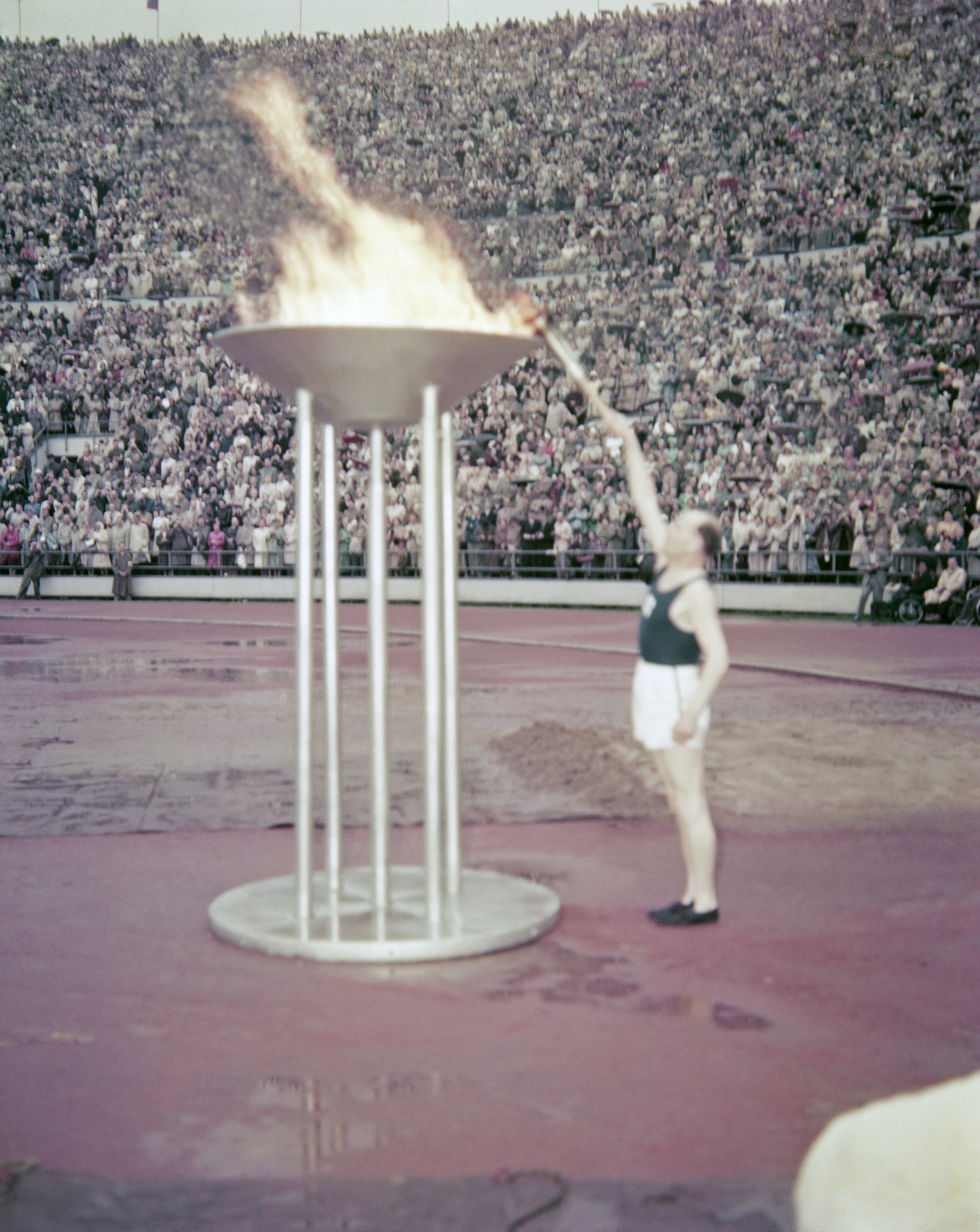
Nurmi felt he received too much recognition as an athlete and too little as a businessman, but his interest in running never waned. He even returned to the track a few times, including a benefit race in 1946 in Stockholm against his old rival Edvin Wide for the victims of the Greek Civil War. His last run was on February 18, 1966, at Madison Square Garden, by invitation from the New York Athletic Club. In 1962, Nurmi predicted that wealthier countries would struggle in distance events, stating: "The higher the standard of living in a country, the weaker the results often are in the events which call for work and trouble. I would like to warn this new generation: 'Do not let this comfortable life make you lazy. Do not let the new means of transport kill your instinct for physical exercise. Too many young people get used to driving in a car even for small distances.'" In 1966, he publicly criticized the state of distance running in Finland, reproaching sports executives as publicity seekers and tourists, and demanding athletes sacrifice everything for achievement. He lived to witness the resurgence of Finnish running in the 1970s, led by athletes like the 1972 Olympic gold medalists Lasse Virén and Pekka Vasala. He complimented Virén's running style and advised Vasala to focus on Kipchoge Keino.
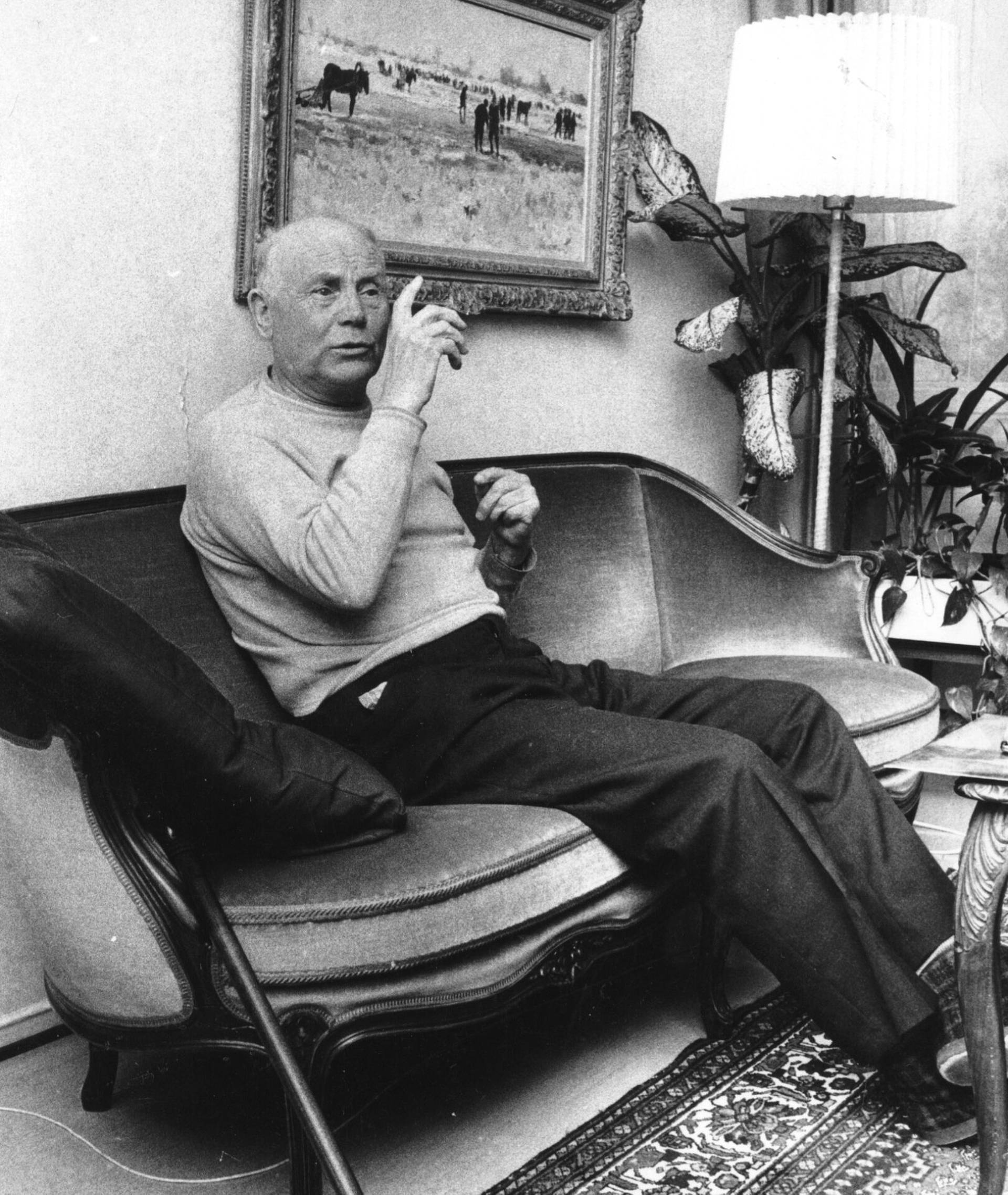
Although he accepted an invitation from President Lyndon B. Johnson to revisit the White House in 1964, Nurmi lived a very secluded life until the late 1960s, when he began granting some press interviews. On his 70th birthday, Nurmi agreed to an interview for Yle, Finland's national public-broadcasting company, only after learning that President Kekkonen would serve as the interviewer. Suffering from health problems, including at least one heart attack, a stroke, and failing eyesight, Nurmi sometimes spoke bitterly about sports, calling it a waste of time compared to science and art. He died on October 2, 1973, in Helsinki and was given a state funeral. Kekkonen attended the funeral, eulogizing Nurmi: "People explore the horizons for a successor. But none comes and none will, for his class is extinguished with him." At Nurmi's request, who enjoyed classical music and played the violin, Konsta Jylhä's Vaiennut viulu (The Silenced Violin) was played during the ceremony. Nurmi's final record fell in 1996; his 1925 world record for the indoor 2000 meters stood as the Finnish national record for 71 years.
6. Personal Life and Public Image
Nurmi was known for his intensely private and enigmatic personality, which contributed to his mystique as an athlete, alongside his personal relationships.
6.1. Family and Relationships
Nurmi was married to socialite Sylvi Laaksonen (1907-1968) from 1932 to 1935. Laaksonen, who had no interest in athletics, opposed Nurmi's desire to raise their newborn son, Matti, to be a runner. In 1933, she told the Associated Press that Nurmi's "concentration on athletics at last forced me to go to the judge for a divorce." Matti Nurmi did become a middle-distance runner and later a "self-made" businessman. The relationship between father and son was described as "uneasy"; Matti admired his father more as a businessman than as an athlete, and they reportedly never discussed his running career. As a runner, Matti's best performance was in the 3000 meters, where he equaled his father's time. In the famous July 11, 1957, race where the "three Olavis" (Olavi Salsola, Olavi Salonen, and Olavi Vuorisalo) broke the world record for the 1500 meters, Matti Nurmi finished a distant ninth, with his personal best being 2.2 seconds slower than his father's 1924 world record. Hollywood actress Maila Nurmi, best known as the horror icon "Vampira", was often referred to as Paavo Nurmi's niece, though this kinship is not supported by official documents.
6.2. Personality and Public Perception
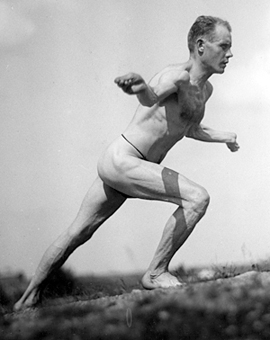
Nurmi enjoyed Finnish sports massage and sauna-bathing traditions, crediting the Finnish sauna for his exceptional performances during the 1924 Paris heat wave. He maintained a versatile diet, though he practiced vegetarianism between the ages of 15 and 21. Nurmi, who identified as neurasthenic, was known for being "taciturn," "stony-faced," and "stubborn." He was not believed to have had any close friends but occasionally socialized and displayed a "sarcastic sense of humour" within his small circle of acquaintances.
Despite being acclaimed as the biggest sporting figure in the world at his peak, Nurmi was famously averse to publicity and the media. On his 75th birthday, he stated that "worldly fame and reputation are worth less than a rotten lingonberry." French journalist Gabriel Hanot questioned Nurmi's intense approach to sports, writing in 1924 that Nurmi "is ever more serious, reserved, concentrated, pessimistic, fanatic. There is such coldness in him and his self-control is so great that never for a moment does he show his feelings." Some contemporary Finns nicknamed him Suuri vaikenija (The Great Silent One). Ron Clarke noted that Nurmi's persona remained a mystery even to Finnish runners and journalists: "Even to them, he was never quite real. He was enigmatic, sphinx-like, a god in a cloud. It was as if he was all the time playing a role in a drama."
Nurmi was more receptive to his fellow athletes than to the media. He exchanged ideas with sprinter Charley Paddock and even trained with his rival Otto Peltzer. Nurmi advised Peltzer to disregard opponents, stating: "Conquering yourself is the greatest challenge of an athlete." Marathoner Johnny Kelley, who first met his idol at the 1936 Olympics, recalled that while Nurmi initially seemed cold, they chatted at length after Nurmi asked for his name, with Kelley noting: "He grabbed ahold of me - he was so excited. I couldn't believe it!"
Nurmi's speed and elusive personality, combined with his mathematical prowess and use of a stopwatch, led the press to characterize him as a "running machine." One newspaperman dubbed him "a mechanical Frankenstein created to annihilate time." Phil Cousineau noted that "his own innovation - the tactic of pacing himself with a stopwatch - both inspired and troubled people in an era when the robot was becoming symbolic of the modern soulless human being." Among the popular newspaper rumors about Nurmi was that he had a "freakish heart" with a very low pulse rate. During the debate over his amateur status, it was joked that Nurmi had "the lowest heartbeat and the highest asking price of any athlete in the world." Even in Japan, far from Finland, Nurmi was a recognized figure; the poet Kōtarō Takamura included a line "Nurmi's nu" in his 1929 poem "A Certain Written Conversation."
6.3. Nicknames
Paavo Nurmi acquired several nicknames throughout his career, reflecting his distinctive running style and reserved personality:
- Flying Finn: A collective term for successful Finnish runners, but particularly associated with Nurmi due to his dominance.
- Phantom Finn: Highlighting his elusive, taciturn, and private nature, as well as his seemingly effortless speed.
- King of Runners or Peerless Paavo: Indicating his supreme dominance and unmatched achievements in distance running.
- The Great Silent One (Suuri vaikenijaFinnish): A Finnish nickname emphasizing his quiet and reserved demeanor.
- Running machine or mechanical Frankenstein: Attributed by the press due to his precise, stopwatch-paced running style and analytical approach.
7. Legacy and Influence
Paavo Nurmi's legacy extends far beyond his numerous medals and records, encompassing revolutionary contributions to athletic training, widespread recognition, and a lasting cultural impact.
7.1. Contributions to Athletics
Nurmi introduced the "even pace" strategy to running, meticulously using a stopwatch to distribute his energy uniformly throughout a race. He believed that this method negated the need for sprints, as a steady and difficult pace would exhaust competitors. This approach elevated athletics to a new level of intelligent effort, making him a harbinger of the modern, scientifically prepared athlete. Nurmi was also a pioneer in training, developing a systematic, year-round program that combined long-distance work with interval running.
Peter Lovesey, in The Kings of Distance: A Study of Five Great Runners, noted that Nurmi "accelerated the progress of world records; developed and actually came to personify the analytic approach to running; and he was a profound influence not only in Finland, but throughout the world of athletics. Nurmi, his style, technique and tactics were held to be infallible, and really seemed so, as successive imitators in Finland steadily improved the records." Cordner Nelson, founder of Track & Field News, credited Nurmi with popularizing running as a spectator sport, stating that his "imprint on the track world was greater than any man's before or after. He, more than any man, raised track to the glory of a major sport in the eyes of international fans, and they honored him as one of the truly great athletes of all sports."
Nurmi's achievements and training methods inspired future generations of track stars. Emil Zátopek famously chanted "I am Nurmi! I am Nurmi!" during his childhood training and based his own system on what he learned about Nurmi's methods. Lasse Virén idolized Nurmi and was scheduled to meet him for the first time on the day Nurmi died. Hicham El Guerrouj was inspired to become a runner to "repeat the achievements of the great man of whom his grandfather spoke," and he became the first man after Nurmi to win both the 1500 meters and 5000 meters at the same Olympic Games.
7.2. Honors and Recognition
Nurmi broke 22 official world records in distances between 1500 meters and 20 kilometers, a record for running. His record for most Olympic gold medals was matched by gymnast Larisa Latynina in 1964, swimmer Mark Spitz in 1972, and fellow track and field athlete Carl Lewis in 1996, and was eventually broken by swimmer Michael Phelps in 2008. Nurmi's record for most medals in the Olympic Games stood until Edoardo Mangiarotti won his 13th medal in fencing in 1960.
Time magazine selected Nurmi as the greatest Olympian of all time in 1996. The IAAF named him among the first twelve athletes to be inducted into the IAAF Hall of Fame in 2012. At the 1928 Olympics, Kazimierz Wierzyński won the lyric gold medal with his poem Olympic Laurel, which included a verse about Nurmi. In 1936, Ludwig Stubbendorf and his horse, named Nurmi, won both the individual and team gold medals in eventing.
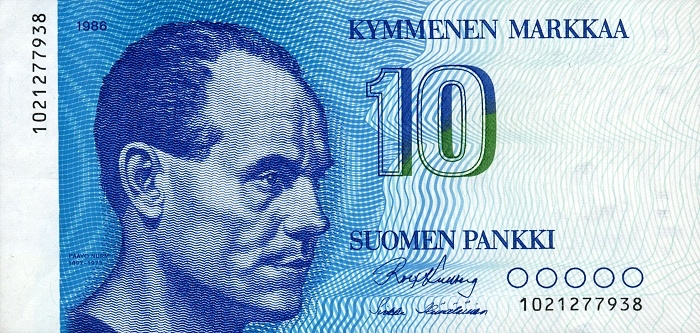
A ten-Finnish markka bill featuring a portrait of Nurmi was issued by the Bank of Finland in 1987. This bill was part of a series honoring prominent Finnish figures, including architect Alvar Aalto, composer Jean Sibelius, Enlightenment thinker Anders Chydenius, and author Elias Lönnrot. The Nurmi bill was replaced by a new 20-mark note featuring Väinö Linna in 1993.
7.3. Memorials and Tributes
A bronze statue of Nurmi was sculpted by Wäinö Aaltonen in 1925. The original is housed at the Ateneum art museum, with copies cast from the original mold located in Turku, Jyväskylä, in front of the Helsinki Olympic Stadium, and at the Olympic Museum in Lausanne, Switzerland. In a widely publicized prank by students of the Helsinki University of Technology, a miniature copy of the statue was "discovered" in 1961 from the 300-year-old wreck of the Swedish warship Vasa when it was lifted from the seabed. Other statues of Nurmi include those sculpted by Renée Sintenis in 1926 and by Carl Eldh, whose 1937 work Löpare (Runners) depicts a race between Nurmi and Edvin Wide. Boken om Nurmi (The Book about Nurmi), published in Sweden in 1925, was the first biographical book on a Finnish sportsman.
Finnish astronomer Yrjö Väisälä named the main belt asteroid 1740 Paavo Nurmi after Nurmi in 1939. Finnair named its first Douglas DC-8 Paavo Nurmi in 1969; Nurmi's former rival Ville Ritola boarded this plane when he moved back to Finland in 1970.
The Paavo Nurmi Marathon, held annually since 1969, is the oldest marathon in Wisconsin and the second-oldest in the American Midwest. In Finland, another marathon bearing his name has been held in Nurmi's hometown of Turku since 1992, alongside the athletics competition Paavo Nurmi Games, which began in 1957. Finlandia University, an American college with Finnish roots, named its athletic center after Nurmi. In 1997, a historic stadium in Turku was renamed the Paavo Nurmi Stadium. Twenty world records have been set at this stadium, including Nurmi's own record in the 3000 meters, John Landy's records in the 1500 meters and the mile, and Emil Zátopek's record in the 10,000 meters.
7.4. Cultural Impact
Nurmi's life and achievements have resonated in various forms of culture. In William Goldman's 1974 novel Marathon Man, Nurmi serves as the idol of the protagonist, who aspires to become a greater runner than him. The opera Paavo the Great. Great Race. Great Dream., with a libretto by Paavo Haavikko and music by Tuomas Kantelinen, debuted at the Helsinki Olympic Stadium in 2000. In a 2005 episode of The Simpsons titled "Goo Goo Gai Pan", Mr. Burns humorously boasts that he once outraced Nurmi in his antique motorcar. The NURMI Study, a research initiative comparing the athletic performance of vegetarian and vegan athletes to those with omnivorous diets, is named in honor of Paavo Nurmi.